#scooby doo mystery style with monsters of the week and an overarching story
Explore tagged Tumblr posts
Text
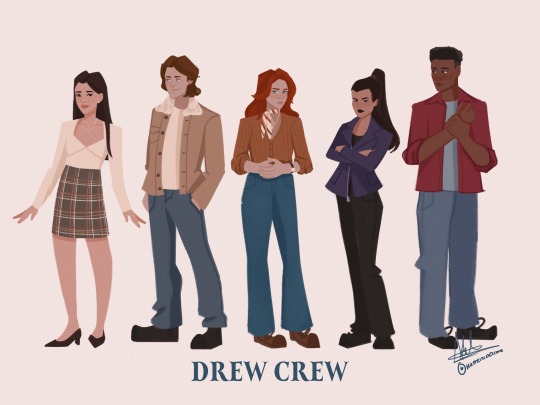
Ghosts are great for business
#nancy drew#ned nickerson#ace hardy#bess marvin#george fan#nancy drew cw#mywork2023#OKAY BUT AN ANIMATED DREW CREW SERIES ;-;#the way I would die for anything honestly giving us moreeee content of them sobs#anything is fine with me really but this would be so fun#scooby doo mystery style with monsters of the week and an overarching story#i need it in my life please
185 notes
·
View notes
Note
Hi! If your client has a bunch of MG books that stand alone but can be considered in the same vein, would you pitch it as having series potential? At what point would you mention the other books?
"Series" can mean different things. But basically, sure, if it has series potential, I'd pitch it as such. And if they were interested, I'd show them a series proposal / pitches for other books in the series. At what point, depends on what kind of series we are talking.
EPISODIC SERIES. Usually following one hero or group of friends or whatever, all set in the same world, with the same general format/style for every book, but with a different issue every book. Each book can be read on its own in any order; the characters don't age much (or they do so very slowly!) These types of series could be literally endless. (Like Nancy Drew, or The Babysitters Club. Or on the TV side, Scooby Doo, the Simpsons, or Law & Order... any sitcom or "monster of the week" type show, really!)
These often ARE conceived as series from the jump, especially for chapter books, so they can all be branded as a series together from book 1. If that's the case, I'd go out with the first book and a series proposal (aka ideas for several further potential books), they might be sold in a multi-book deal. This happens ALWAYS with chapter books (I'd never go out with a totally stand-alone chapter book, publishers buy them in multi-book deals all the time) -- and sometimes but less often with MG books.
ANTHOLOGY SERIES. This is like an off-shoot of the Episodic style series. In this type, the series as a whole has a theme, and every book has the same kind of tone and length, but every book theoretically stands alone and is sometimes vaguely associated with the others, but doesn't have to be. Examples: Goosebumps - usually different kids/different monster in every book though sometimes popular ones make a reappearance, I'm lookin at you SLAPPY! I Survived - different disaster every book. On the TV side, Twilight Zone is a good example -- the only thing REALLY tying those stories together is the tone/style and narrator, each episode is its own thing.
This would likely be conceived as a series from the jump, as above, and if that's the case, again, I'd go out with the first book and the series proposal from the start.
PROGRESSIVE SERIES: Usually following one hero or group of friends or whatever, all set in the same world, and with different issues every book, BUT, there is a "Big Bad" or mystery or something that the overarching series is trying to solve, a story told the whole series long, time passes during the series, you DO sort of have to read them in order to get the full effect, and there is a conclusion. Like Harry Potter, or on the TV side, any "Limited Series" type show. White Lotus, say.
IF book one CAN stand alone -- like, the story of the book concludes, BUT there is obviously more story to be told / a larger thing happening -- I'd probably go out with it as a stand-alone but mention that there are more potential books, that it could be a series, and I'd have a series proposal that sketches that out, etc, and if they liked it they might want to know what future books would look like, so I'd show that to them at that point..
COMPANION BOOKS. These books completely stand alone, BUT they are set in the same world. So maybe each book is about different members of the same family, or a group of best friends -- each one has a story that is totally discrete, the series aren't numbered on the spine, you can read them in any order. (MANY MANY Romance novels are this way -- think Bridgerton, where each Bridgerton sibling gets their own book with their own romance, and yes, the other characters make cameos, but you don't need to have read their book to understand what is happening at all! On the kid's side, the Casson Family book by Hilary Mckay is an example.)
This, I'd likely go out with whatever book as a stand-alone, but mention in the pitch that there are ideas for other books set in the same world, each following a different sibling / friend / whatever. And if they were interested, talk to them about that or show them brief pitches of other potential stories. But this would probably sell as a stand-alone, and if it did well, they might add more books.
47 notes
·
View notes
Text
FotW: SDMI - Beware the Beast from Below
Welcome to Freak of the Week, where every Sunday I tackle something Non-Skylanders since that series has a billion characters I need to give their own individual reviews. Fotw is my way to get more content out on a decent schedule, tackling the Monsters, Villains, and Foes who take turns every week to harass the Hero of their specific media.
For these first few months we'll be covering a series dear to my heart, Scooby-Doo! Mystery Incorporated. Every episode covers a crook who, for reasons that will become known eventually, decides that the best way to successfully commit a crime is to dress up as a giant crab or Cthulhu while doing it. Luckily a gang of budding stoners and college dropouts are there to solve the mystery and do the job the police are too lazy to do themselves.
Points to realism.
Let's begin with our introduction episode, and first baddie, The Slime Mutant!
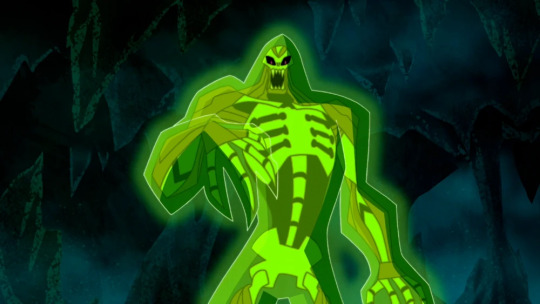
Backstory: Sewer Workers working underneath the town of Crystal Cove knock down a wall revealing a hidden cavern system that contains barrels of unknown, radioactive material. These caverns seem to run underneath the entire town and will come back in several episodes holding their own mysteries.
The Sewer Workers, playing into their roles as the pre-intro horror movie victims they are, decide to pop open one of these barrels to investigate further. This seemingly unleashes a mutant made of radioactive slime, who thanks their help by cocooning them in vibrant green goo.
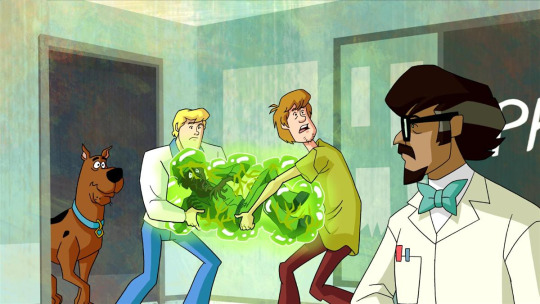
Please appreciate how horrific these cocooned victims look and remember this when we get to the reveal.
Design: The Slime Mutant is a humanoid creature with exaggerated human anatomy whose skin is see-though. It's covered in a coating of iridescent green slime and has a muscular body type with a cinched waist. Its skull has needle-like fangs and glowing red pupils in its empty eye sockets.

While most of the anatomy we see through its slimy epidermis is bone, similar to a cartoon x-ray gag, some of its skeleton still retains muscle tissue around limbs, neck and lower jaw which gives the monster a really cool appearance reminiscent of someone who's been half-melted in cartoon acid. The muscles also seem to exist as a way to explain how the creature moves, as its body lacks the full viscous stretchability most slimes have. It instead lumbers around like a zombie, with muscle tissue remaining in places where they'd be needed for movement. This attention to detail is especially fun when you realize who the culprit is and why they'd include that detail.
Combined with the show's sharp art style, it turns a pretty simple creature concept into an iconic new monster. Its powers include the ability to petrify, and also mummify(?), victims in its green slime - which it blasts from its palms like a Dragonball character.
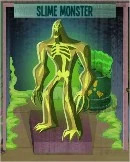
Reveal: Mystery Incorporated is hailed as one of the best interpretations of Scooby-Doo, taking the concept and allowing its characters to exist in a setting that changes every episode as it ditches the episodic formular of past series for a story-driven reboot with multiple arcs and an overarching mystery each season. It's still Scooby-Doo however, so every episode follows the same formula more or less.
You get two or three suspects (oftentimes just additional named side characters tied to the plot of this episode), whoever the gang settles on prematurely as the culprit is innocent, and the gang traps the crook and unmasks them at the end of the episode.
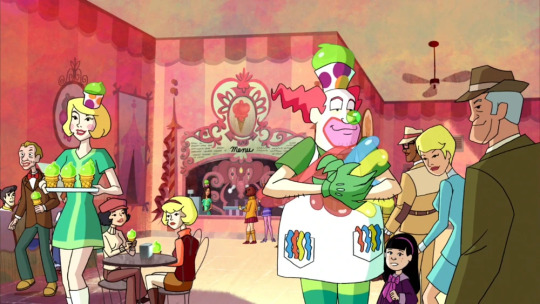
Our first suspect is Franklin Fruitmeir, a strange clown man who recently moved into town to sell his dessert product, which is neither ice cream nor gelatin, but something else entirely. Scooby ends up tasting the slime mutant's goo and discovers that its ooze is not radioactive waste, but radioactive frozen treats.
One can only imagine what it does to your insides if getting covered in the stuff turns you into a pickled corpse.
We never really get to see what happens to the sewer workers in this episode, so I assume they died.
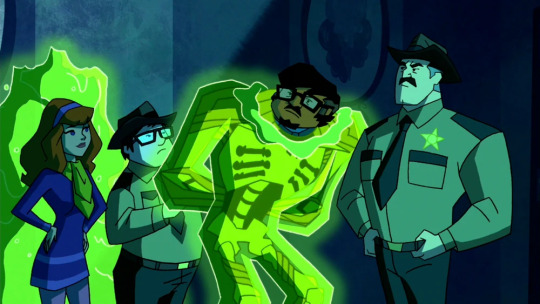
Our first culprit is Professor Emmanuel Raffalo, who worked as a science teacher at the gang's school. Turns out that he was going to use the caverns to dig under Crystal Cover bank to rob it - framing Fruitmeir for the crime by using the dessert product in his scheme.
Yes, it is because a teacher's salary isn't cutting it anymore.
youtube
5/5 -Great Start with a unique execution of a classic monster, who doesn't love slimes?
#bmoreviews#bmoreviewsmysteryinc#mystery incorporated#scooby doo mystery incorporated#slime#slime mutant#cw body horror#scooby doo#bearmemesfotw
5 notes
·
View notes
Note
Which Scooby-Doo material do you most highly recommend?
alright, gotta start with the classic: Scooby-Doo, Where Are You! is a super fun monster-of-the-week mystery show with a lively, memorable cast to back it up. The spooky background art is gorgeous, and I’ve probably genuinely never been bored watching an episode from that OG run. Highly recommended.
I hold Scooby-Doo on Zombie Island and Scooby-Doo and the Witch’s Ghost in the same regard tbh, both are really good and super spooky. Perfect to cap off your Halloween vibes for the month if you haven’t watched them already. That string of direct-to-video movies saved the Scooby-Doo franchise from its 80s burnout, but Zombie Island and Witch’s Ghost are my favorites of that bunch.
Scooby-Doo! Mystery Incorporated is probably one of the best things Warner Bros. has allowed to be done with the Scooby brand. Period. If you’re a Scooby-Doo fan, Hanna-Barbera fan, horror fan, overarching-story fan, sci-fi fan, mystery fan, or all of the above (as you should be), Mystery Incorporated has something for you. The dynamics between the gang’s members are so thoughtfully fleshed out, and the animation work (both the character movement and the background art) is awesome. If you really want a testament as to how good this adaptation is, they somehow made Fred an interesting and engaging character in his own right. I can’t recommend this one enough.
The live-action movies from 2002 & 2004 are so fun and (I can’t reiterate this enough) so well cast. Everyone really becomes their characters, and I never for one second doubt that Matthew Lillard is fr talking to his best friend who is also a dog. I personally slightly prefer Monsters Unleashed over the first movie, but both are still awesome.
I actually think Be Cool, Scooby-Doo! is really funny if you’re willing to give it a chance. I fucking hate the stupid ass Family Guy art-style they went for, but the funny voice work and the dry comedic writing pulls it together. I think it just got a lot of flak back in the day for being the next Scooby-Doo show after Mystery Incorporated ended, which was more serious and had an overarching plot, whereas Be Cool is more comedic and episodic. Kind of a “Teen Titans Go! being released after the cancellation of Teen Titans” situation, except Be Cool is actually good. Definitely try it out.
5 notes
·
View notes
Text
So I watched Skip Intro's Video on Veronica Mars and it brought back my obsession with it full swing so I was rewatching it and consuming fanon and thinking about only Veronica Mars for like. 2 weeks? And then I got to the movie and S4 and no obsession I've ever had has stopped on such a dime like watching the second half of season 3 and the Veronica Mars Movie.
And it's not the ships. Obviously every time Veronica and Logan break up and date other people it's a wasted lazy subplot that could've been screen time for some of the amazing and wonderful side characters. Give Wallace and Mac and Weevil and Keith more to do. Give them subplots. Or maybe focus on the mysteries and overarching plots of the show.
The video, which you should absolutely watch, focuses on what I consider to be 1 side of the VMars coin. The noir stylings which pair perfectly with the anti-establishment distrust of authority. The real world problems and the fact that the systems in place are corrupt and only benefit those in power. The "Laws are threats" type message where the only force for good is Veronica and like minded people trying. Doing whatever they can to make the world better by fighting and subverting the system.
The other side of the coin is the teen girl drama of it all. Veronica is Not Like Other Girls. But She USED TO BE. it's pretty pink prom dresses and pep squad snickerdoodles. It's the contrast and juxtaposition between the life she's "supposed to be living" the life she WAS living, the genre she used to be in. Before the show started, and now. When her life is a noir film. This side of the coin. Who still secretly cares about grades and boys and what her hair looks like. Who can effortlessly code switch between tough as nails and marshmallow soft. That compassion matters. That you need to take the time to do something nice for a friend when the world is ending. That you should remember Lilly floating in the pool and giggling, and also catch her killer. That's the show. It's the perfect balancing and blending of these two ideas that makes the first season so compelling.
When that balance tips too far in one direction the show stops being fun, or stops being interesting, or worse both.
All this to say. I think there needs to be a place for mystery shows that are geared towards different demographics AND criticize existing systems. I've spent my whole life obsessing over media that's all about mysteries and beyond that seeking justice. Scooby Doo, Nancy Drew, Veronica Mars.
The big problem these days is that so many mystery shows focus on law enforcement, but that is disingenuous and boring. They have to buy into the system, making them all some degree of copaganda, even those that try to criticize it fall short because they're still inherently tied to the system, and they're repetitive. When you buy into the law enforcement complex of America, you basically reinforce the status quo which doesn't do anything interesting with the mysteries or the complexities of the problems inherent in the system.
A children's TV show where the spooky monster is a man in a mask who's trying to manipulate the price of real estate or whatever is fundamentally a better story than this guy kills people and baits cops into elaborate schemes because he's crazy.
Even the shows that aren't about law enforcement are often about law enforcement consultants and still work within the system. Like. Sometimes the cops are comically bad at their jobs and that's better than having them be the heroes but there's still this reinforcement of belief in the prison industrial complex.
I think Veronica Mars should've grown up to be an investigative journalist taking down corporations and exposing politicians. Like. Spotlight level journalist. Which is dangerous and exciting and spooky and glamorous in the noir style, but engages with the issues inherent in our current judicial system in a way that's more interesting than her joining the FBI or being a Lawyer or even being a PI.
I think the modern version of VMars would be like. A darker version of Only Murders in the Building. With a focus on journalism and exposing the horrible truths beneath the surface of Neptune and its law enforcement.
This was all over the place but if you made it this far pls let me know what you think and please recommend me mystery media that's not about cops.
#kittythelitter rants#rant post#Veronica Mars#media criticism#what I wouldnt give for a darker edgier only murders in the building.
1 note
·
View note
Text
Miraculous, the Monster of the Week Format and the Status Quo, or Why Things Barely Change At All
TLDR; while the monster-of-the-week format doesn’t mean there is no overarching plot in Miraculous, these monsters are variable in terms of quality and the overarching plot itself is not something the show explores.
The fact that you can watch 80% of the show in any order without feeling lost is quite telling: the goal is to have self-contained stories during the space of one episode, not to have things that happened in such and such episode have consequences in the following ones. Which is frustrating in the long run, even more so when the monster-of-the-week format doesn’t mean that episodes are aired weekly.
It isn’t that the people working on Miraculous aren’t talented enough to write something good, simply that the format they have to work with makes the story what it is.
Now, if you want to read something a little more detailed, just click the thingy!
With now 64 episodes aired, it’s safe to say that Miraculous is a show that is meant to stay on our screens for quite some time. For exactly five seasons, so far. Yay! Or perhaps not?
With its reused villains (when you’ve got 2.0 in your title, that screams Electric Boogaloo, I’m sorry), its apparent lack of character development and little focus on the overarching plot (if there is any, at this point), it sounds like this is pretty much stretched out.
The show has two focuses, so to say, our two cinnamon buns and their love story, and superhero stuffs with different villains in each episode (and that guy alone in his lair, and sometimes that woman with the fan but eeeeh, don’t sweat it, besides they’re interchangeable so far)
What do I mean by Monster-of-the-week format?
Exactly what the title says. For each week/episode, one villain. Who is defeated at the end of the week. Yay! The prime example of this is the original Scooby Doo cartoons, Scooby Doo, Where Are You!

Now, what do we think of that show? Other than the laugh tracks, it holds up well enough. More importantly, though, every story is self-contained, and the appeal of the Scooby Doo is its mysteries. We don’t care about Velma’s backstory, or how Fred became the leader, these characters have very little depth and that’s OK, their interactions is not the main point of the story.
Scooby Doo has a very simple formula:
The gang goes somewhere, finds mystery, chase one, traps, chase two with a bubblegum pop soundtrack this time, then the mystery is solved, very basically. And we can move on to the next mystery
You can air any episode in any order, you can get the story without feeling lost.
And for most Miraculous episodes, it is true as well! They follow roughly the same recipe:
Something something civilian life, Hawk Moth akumatises someone, Superhero Time, Lucky Charm, Status Quo again.
The first episodes that aired never explained how Marinette got her Miraculous and… It didn’t seem to matter all that much?
But there’s a problem here. MLB isn’t just about Superhero Thingies™. We’ve got that Love Tesseract™ thing too. And a love story requires a progression and character growth to work.
You can’t have a monster-of-the-week format if you try to explore things that are character-driven, unless there is a clear follow up, an overarching plot.
Like, say…
Revolutionary Girl Utena.

Utena is one of my favourite shows of all time, and I’m talking live action and animated. It is stylish, the writing is great, the direction work is awesome. It’s a masterpiece and for a show aired in 1997, it aged pretty well in the way it handles it themes. (some of the animation is wonky, though, characters are definitely not always on model, it’s not perfect but hey, 1997)
You should watch Utena. It’s available on Nozomi if you’re from Americaland, otherwise I’m sure you’ll find a way to stream it somewhere. Or buy the BluRay.
So, Utena has a “Duel of the Week” format, it follows a clear formula. And just like Miraculous, it recycles animation and some sentences are said at least once or twice per episode. Hell, Miraculous references Utena quite a few times (but I’ll make a post just for that).
Having a repetitive formula does not mean you cannot have a sense of progression. And Utena shines because of that. Things… Things have consequences, a duel leads to another because of reasons that become clear. It’s not a “we need that many episodes” thing, everything is needed, you cannot not watch an episode, even the recap ones, even the Nanami ones, especially the Nanami ones (Nanami who is a much better Chloé than Chloé is).
Unlike Miraculous, Utena has an overarching plot, you can’t play the episodes in any order. Repetitions and variations are meaningful in Utena, it is not simply a matter of style, or rather, style in Utena is meaningful, not only there for “the show”, a spectacle which in itself is meaningful too. Hell, everything in Utena is meaningful. Meaningful. Could you imagine that much meaning in Miraculous? Me neither.
But, you may say, you’re not fair; you’re comparing Miraculous, a show aimed at schoolchildren, with Utena, an anime aimed at an older audience.
And you wouldn’t be entirely wrong if you thought so. Which is why I’ll reiterate my point with a show for which Thomas Astruc himself worked.
Code Lyoko
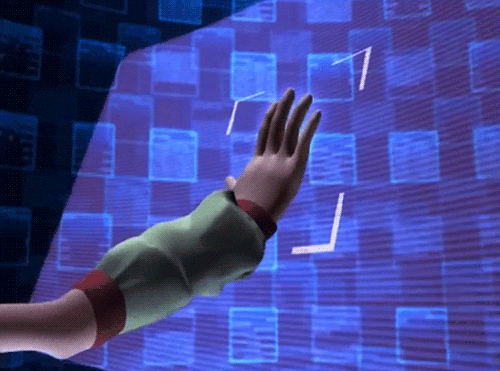
Code Lyoko is super formulaic, replace Hawk Moth with XANA and superpowers with going inside a computer and that’s about it. It recycles a lot of its animation, the character design is… A bold choice. I barely watched it when I was younger though it was a pretty big thing for us Frenchies (but hey it’s available on YouTube now in French so I binged the entire thing in a few days and while it’s not groundbreaking, it does some things really well)
Code Lyoko is all that, repetitions, terribly formulaic, XANA-tised person/plushie of the week thing with towers to deactivate and whatnot, and a “return to the past” to erase whatever has occurred during the episode. Literally.
But.
Once again, a visible overarching plot, and can you believe it, things have consequences. William is lost on Lyoko, and the kids spend episodes looking for him. There’s romance, and though it is dealt with clumsily, there’s a sense of progression to it. Things… Happen… With… Consequences.
Miraculous is, for the most part, an inconsequential show

Yeah, the problem with Miraculous is that its overarching plot is muddy and flimsy, the status quo is very much that, I’d argue that it’s a show in which nothing truly happens because nothing has consequences. I mean… Nino and Alya are dating, I guess? Adrien… Is still allergic to pigeon feathers? There are sometimes more than just two heroes? But it doesn’t really matter.
And Oblivio is the perfect example of that.
That’s the message of the episode. Even if we forget things, it still works, there is no need for memory, for remembering what has happened in all the previous episodes because we still make it work somehow. What happened before this episode does not matter to the story we are telling now.
The show keeps telling the same things about its characters, over and over, and whenever something new is introduced… Well it’s great but don’t expect to see it in the episodes after that one.
Which is why specials, story arcs which last two episodes, are good. There is room for developed character moments, interesting interactions, plot, sometimes good fights too. Chloé shines in Queen’s Battle, “Origins” is, for me, probably the best bunch of episodes in the entire show so far because things happen and we can see change happening. Like, actual change. Characters who learn how to do stuff, whose interactions with one another changes over the course of these two episodes.
Outside of this however… Here, have that very important book, we’ll see it in one or two episodes because we need a macguffin and voilà. Here, have new heroes, but don’t expect to see them after that episode, unless we need a real showdown.
It’s hard to get hyped by Jeremy Zag’s posts, because no matter how cool Dragon!Kagami looks, because of that format of self-contained stories with the only connection being them being the same static characters. Kagami with a Kwami? Eh. It’ll be a one-off thing, sure it’ll be cool but to make the plot move on… Don’t sweat it.
Speaking of Kagami, she is presented the exact same way in Frozer and Selfinsertepisode Animaestro, nothing has changed about the character, don’t worry, she’s still going to be used the exact same way, perhaps we’ll show once again that she really cares for Adrien but hey, we already knew that, there’s nothing new in Onichan. And that is symptomatic of the entire cast.
Is that format something the creators of the show absolutely wanted? Is near-stagnation what they wished for? Let’s decide it’s not their choice, and that they try their best with the limitations they have.
Would these flaws be this glaring if new episodes were aired weekly? Like, say, air three episodes during three weeks, a break and then some new episodes again? I think not. The wait and the lack of follow-up from one episode to the next makes them really noticeable, and watching them feels unfulfilling.
So that airing schedule I just suggested? That’s not how things work, that’s not how television works apparently and there’s nothing the people who work on Miraculous can ask about it. Thomas Astruc doesn’t know when the episodes will air, blah blah blah. Television networks not really caring about the shows they air? Never heard of that before, huh. SU
So I guess this is it, then. I hope you enjoyed this overlong post!
(shameful self-promotion moment, but about Kagami, I wrote a Kagaminette/Marigami fic, it’s 80,000 words so far and I update it on Mondays so give it a look if you want! It’s here.)
#miraculous#love square#marinette dupain cheng#adrien agreste#ladybug and chat noir#kagami tsurugi#this show#could be so much better#instead it's a frustrating watch#rena rouge#carapace#hawk moth#thomas astruc#oblivio#monster of the week
6 notes
·
View notes